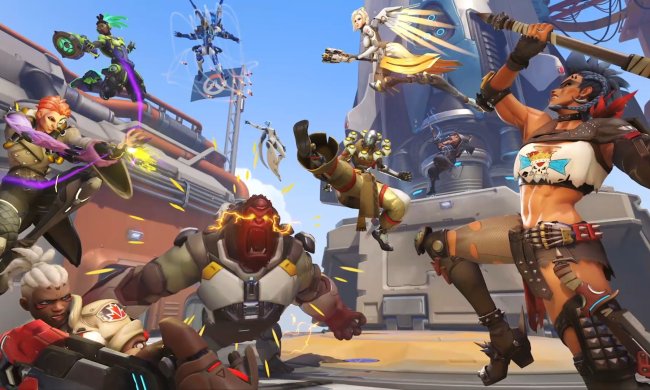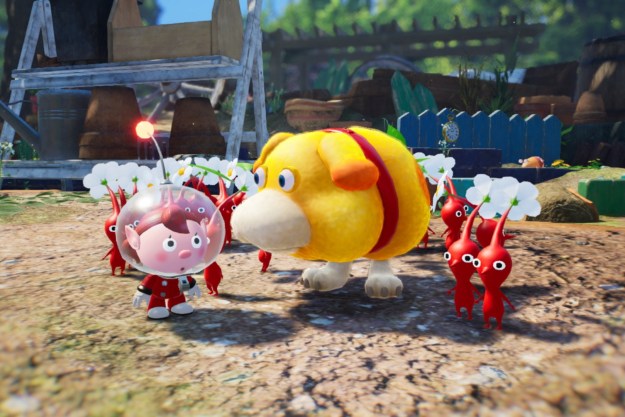
“Pikmin 4 reworks a familiar strategy formula to create a more satisfying adventure about the power of efficient multitasking.”
- Streamlined strategy systems
- Charming visual style
- Strong progression hooks
- Wealth of meaningful side content
- Lots of hand-holding
- Lock-on frustrations
Though I’ve played every game in the Pikmin series, I have a confession to make: Pikmin 4 is the first installment I’ve actually beaten. And that’s all thanks to the power of Dandori.
Early in the latest entry of Nintendo’s oddball strategy series, a pint-sized astronaut introduces me to the Japanese concept. “Dandori is the art of organizing your tasks strategically and working with maximum efficiency to execute your plans quickly,” he tells me. It isn’t just a bit of space-filling NPC dialogue, but rather a key that would finally teach me how to play a Pikmin game more than any tutorial I’ve ever experienced in the series.
In previous installments, I’d been conditioned to think that chaos was inevitable. No matter how hard I’d try to keep an army of plant soldiers in line, I was almost powerless to stop some kind of slapstick extinction event that would grind my playthrough to a halt. With a simple attitude adjustment (and a lot of quality of life tweaks), I’d become a confident leader capable of juggling multiple tasks at once while minimizing accidents. Pikmin 4 might be the best life coach I’ve ever had.
Though faithful fans might be put off by a more laid-back sequel that’s over-eager to hold players’ hands, Pikmin 4 is a purposeful reconstruction of Nintendo’s most niche series. A stressful comedy of errors becomes a digestible puzzle-strategy hybrid that gives players valuable organization strategies that are just as useful in real life as they are on their Nintendo Switch adventure.
The art of Dandori
Pikmin 4 has all the same gameplay hooks as its predecessors, yet it feels like a very different game. Players take control of a custom-designed astronaut sent out on a mission to find Captain Olimar, the series’ usual hero, who is marooned on a mysterious planet alongside his crew. To track down the missing explorers, players team up with the planet’s adorable Pikmin population to improve their ship’s radar by collecting gobs of treasure. It’s the same light strategy hook that’s always made the series special, as I direct my little comrades like rows of worker ants. Together, they can carry heavy objects, break down rock walls, and beat the snot out of adorable critters 100 times their size.
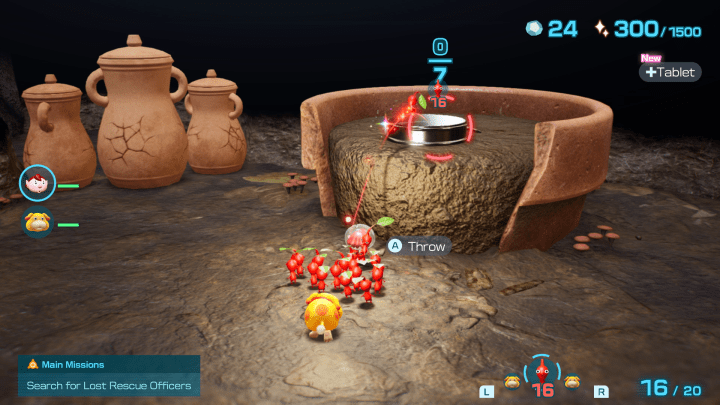
Where it diverts from the formula, though, is more in its design philosophy. In the original Pikmin, Captain Olimar would quickly amass an army of 100 Pikmin and race against the clock to fix his destroyed spaceship within 30 in-game days. It was an at-times overwhelming premise that would teach players to get their act together through hard failures. Each Pikmin title since has slowly chipped away at that stress, but Pikmin 4 is the most radical reinvention yet. It’s more interested in teaching players helpful organization tricks rather than throwing them in a sink-or-swim situation. That’s clear early on from a slow, tutorial-heavy introduction that’s loaded with NPC chatter. It’s a disappointing opening that’s overly reliant on Nintendo hand-holding, but it fortunately loosens up after a few hours.
Other noticeable tweaks are far more effective. For instance, players only start with a squad of 20 Pikmin this time around and slowly build up to 100 by collecting “farlic” bulbs throughout the story. It’s a small, but impactful change that gives the adventure a better sense of mounting progression and complexity. Though what’s more impressive is how that change actually makes me a better Pikmin player. By starting with a smaller group, I’m able to focus on manageable tasks and slowly build up my multitasking skills gradually. When I start the story, I’m focused on one or two things at a time, as I use my small army to carry one piece of treasure or take down a single Bulborb. By the time I hit 100, I’m more naturally able to split the group’s attention and have 10 tasks carried out at once. I’ve never really achieved that in a Pikmin game before, but it felt like second nature here.
That’s also made possible thanks to a more streamlined command system, as my astronaut’s cursor snaps onto objects my Pikmin can interact with. Though it can get a little frustrating when there are multiple objects bunched close together, I’m able to quickly throw out Pikmin and know they’ll actually carry out the task I’m asking of them rather than wind up idling around. I’m also able to select exactly which type of Pikmin I’d like to toss by cycling through each with the right shoulder button. That reduces those dreaded moments when I’d accidentally send a red Pikmin to its watery grave. With those changes, I’m able to direct traffic with confidence and focus more on getting as much done in a day as possible rather than playing babysitter.
Every change here works in service of the sequel’s Dandori focus.
Pikmin 4 goes to great lengths to make sure that I’m always firmly in control of any situation and always have a chance to fix my errors. My Pikmin pals don’t lag behind very much when I’m running around anymore, reducing instances where helpless critters wind up lost. Pikmin aren’t nearly as fragile as they were in previous installments, so it’s rare that I stumble into an extinction event. Even if I do, a generous rewind system makes sure that I can always turn the clock back and tackle a situation differently. That means no more game-killing moments where my friends get gobbled up by a Burrowing Snagret.
For some long-time players, that suite of quality of life improvements may sound disappointing. Pikmin’s appeal has long been its difficulty, as players must persevere in the face of chaos. Every change here, though, works in service of the sequel’s Dandori focus. Pikmin 4 isn’t about taming nature; it’s about taming your own busy brain. It encourages players to approach each day like its own time management puzzle, finding ways to get as many tasks done as possible thanks to efficient planning and execution. The bulk of my satisfaction came from seeing how high I could raise an area’s completion rate in one day, all while growing my Pikmin army and raising my treasure score. That idea works in concert with Pikmin’s winning puzzle-strategy formula to create a more laid-back experience filled with applicable life skills.
Neatly organized
While those base level formula tweaks stand out, Pikmin 4 includes some bigger changes that make it feel like a reinvention rather than a continuation. That’s immediately clear in its reworked visual approach, which gives the adventure a more playful, suburban backyard aesthetic, but there are several new parts under the hood. It feels much closer to last year’s indie charmer Tinykin with an emphasis on puzzle solving over strategy combat, but it’s a greater structural overhaul that really sells the new direction.
That same satisfying multitasking that’s present in the moment-to-moment gameplay carries over to the progression hooks surrounding it.
You can’t practice Dandori without a to-do list, and Pikmin 4 is loaded with ones that I actually enjoyed checking off. There’s a treasure collection to complete, an enemy encyclopedia to catalog, missing crew members to hunt down, and much more beyond the main treasure hunt. Most effective is the inclusion of optional side-quests that can be completed naturally while playing the main adventure. If I’m building a bridge with materials I’ve gathered or rescuing an astronaut in a level, I’m usually also working toward a side goal. That same satisfying multitasking that’s present in the moment-to-moment gameplay carries over to the progression hooks surrounding it.
There’s a much stronger sense of reward for getting those tasks done, too. Side-quests pay out a chunk of crystals that can be used to upgrade my character’s suit, give them helpful gear that makes Pikmin organization easier, and buy items like ice bombs or sticky mines. The more tasks I complete, the more tools I get that allow me to lead my squeaky army with greater efficiency. I never feel like I’m wasting my time with busy work, as every completed task will ultimately save me some time down the line — something I probably need to tell myself next time I let my sink pile up with dishes.
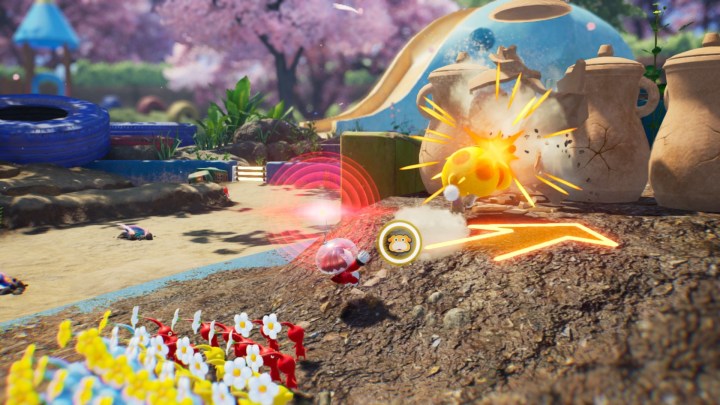
The smallest mechanical additions make my list of quests even more manageable. Players can set different commands to D-pad shortcuts, giving them more control over their leadership style. In my setup, I set specific buttons for disbanding my Pikmin, sending out my survey drone, and bringing up my mission list on the fly. Those customization options go a long way toward keeping me in a flow state as I direct my critters like a skilled conductor.
I’m not alone in my quest for maximum organization. In addition to the usual Pikmin army (which introduces an extremely useful ice type capable of freezing enemies), the sequel brings a helpful new companion in Oatchi. The adorable dog can be commanded like any Pikmin to attack enemies, carry objects, smash through clay pots, and much more. I can also control Oatchi independently, riffing on Pikmin 2’s complicated two-character hook in a way that feels a lot more manageable considering how much cleaner Pikmin commanding is overall. Oatchi even has his own skill trees filled with useful upgrades, adding even more ways to complete the story’s most daunting tasks with ease.
Put your multitasking to the test
With a less punishing gameplay loop, Pikmin 4 has to find other ways to provide meaningful challenges that put players’ Dandori skills to the test. What’s especially impressive about the package is just how many ways it’s able to do that. The most familiar test comes from multi-level dungeons that have me completing tight puzzle gauntlets and fighting tough bosses, but Pikmin 4 finds a lot of new ways to twist the series’ standard formula to turn multitasking into a more versatile gameplay hook.
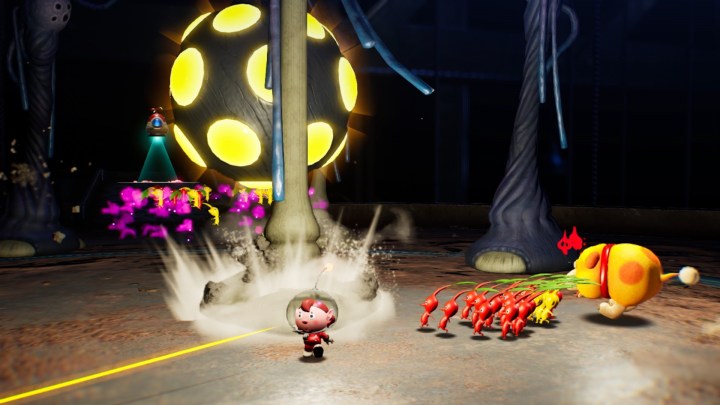
In Dandori Battles, for instance, the entire formula is distilled into a tense split-screen battle where I need to gather more treasures than my opponent in a few short minutes. It’s a hectic sprint that has me making reactive, split-second decisions on the fly rather than executing a well-thought-out plan. It’s a surprisingly fun, if limited, multiplayer mode that’ll have friends cursing one another. Similarly, the story contains timed dungeon challenges where I need to hit a certain treasure score within a time limit, testing how well I can sight-read puzzles and prioritize tasks. In Pikmin 4, the worst mistake I can make is leaving my critters with nothing to do.
The biggest twist on the standard formula comes in the form of its creative night expeditions. The new mode puts players in a tower defense minigame where they need to protect sandcastles using a new green glowing Pikmin type. When an expedition begins, players have a minute or so to grow their glow Pikmin army by carrying crystals back to the sandcastle. Once a certain amount of time passes, creatures around the environment grow enraged and start to attack. The goal is to fight them off until sunrise, using the army of green Pikmin they amassed at the beginning and issuing Oatchi commands. It’s another smart (though sometimes repetitive) juggling act that tests players’ ability to refresh their ranks, take on waves of dangerous enemies, and keep casualties to a minimum.
It all makes for a package loaded with meaningful content that puts the series’ strongest ideas to work.
That, combined with a story that took me around 15 hours to finish at nearly 100% completion, would already make Pikmin 4 a fairly loaded package. It doesn’t stop there, though. Without giving its most fun surprises away, there’s a surprisingly lengthy endgame included that doubled my playtime with valuable story-driven content that would have been saved for DLC in most other games. There’s a more challenging second story campaign to work through and a bonus mode that should please those who miss that more stressful experience. It all makes for a package loaded with meaningful content that puts the series’ strongest ideas to work.
The more I play, the more it feels like Pikmin 4’s developers practiced what they preached here, taking a Dandori approach to game development. The adventure grabs various ideas from the series’ past and puts them all in order, like someone shuffling a handful of loose-leaf papers into one neat stack. At its heart, this is the same series I’ve enjoyed for two decades, but I feel like I’m seeing it in a whole new light thanks to a thorough reorganization. I don’t know that I can name any other game that made me excited to do my household chores every time I powered it down (if only my lazy cat was as helpful as Oatchi).
Pikmin 4 was reviewed on a Nintendo Switch OLED in handheld mode and on a TCL 6-Series R635 when docked.



